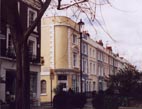
Route & what to see
|
A Notting Hill Walk Route & what to see |
| london-footprints.co.uk |
Notting Hill is known for a number of things; the huge Carnival that takes place on August Bank Holiday weekend, the Hugh Grant film and the Portobello Road with its market. Until 1864 there was still a Tollgate, on the site of the station (built in 1868). Gravel pits had been dug along present Notting Hill Gate and although this area was quite developed in 1841 lanes led northwards across fields to Notting Barn and Porto Bello Farms. What was to become the Ladbroke Grove estate was at this time the Hippodrome Racecourse and alongside this were the Potteries & Piggeries, notorious slum areas. Colourful terraces and interesting shops feature on this walk along with 4 cinema buildings. The busiest day is Saturday but there stalls on other days with markets on Portobello Green on Fridays & Sundays.
This 5 mile walk begins at Notting Hill Gate tube station and finishes at High Street Kensington although it can also be done as a shorter circular walk. Ladbroke Grove Station is on the route. An alternative shorter route is available [click here].
Follow 'Portobello Road' exit
signs from the station and go along Pembridge Road and left along
Portobello Road
Number 22 has a blue plaque to George Orwell. The market began in
the 1860/70s as a herb and horse-trading centre for local
gypsies. There are antiques & collectables at the southern
end, fruit & vegetables in the centre and new &
second-hand goods at the northern end.
At Westbourne Grove take this
to the left
Now an antiques centre the 20th Century Cinema opened in 1866 as
the Victoria Hall, later becoming the Bijou.
Left along Kensington Park
Road
The classical St Peter's church was designed by Thomas Allom in
1855 along with the surrounding housing in an Italianate style.
Right at Stanley Gardens,
right along Stanley Crescent and right at Ladbroke Gardens.
The houses are separated by attractive private gardens.
Left along Kensington Park
Road, left at Westbourne Park Road and right at Ladbroke Grove.
On the right is the North Kensington Library of 1891
Continue past the tube station
and under the Westway, opened in 1970, then go right along
Cambridge Gardens alongside Portobello Green.
Stalls are set up under the awnings on some days.
Turn right into Portobello
Road and first left through to Tavistock Road
Alongside is a small park.
Right along All Saints Road,
right at Westbourne Park Road and left along Portobello Road
On the right is the purpose built Electric Cinema of 1911. Notice
the box office and tiled floor in the foyer.
Left along Colville Terrace,
right at Colville Road then right into Westbourne Grove
The distinctive toilet and florist building was designed by Piers
Gough
At Portobello Road go to the
right along this, then left into Elgin Crescent. Follow this
through to Clarendon Road then cross this into Portland Road. Go
ahead into Avondale Park.
Opened in 1892 this former area of slurry called 'the Ocean' was
part of the notorious Piggeries as well as the location of tile
kilns and brickfields.
Exit into Walmer Road further
along where a tile kiln remains. Go to the right alongside the
church of St Francis of Assisi (Pottery Lane) then first left
along Penzance Place back into Portland Road.
Hippodrome Place on the left is a reminder of the Racecourse that
once covered a large area here from 1837-42.
Go to the right here along
Clarendon Cross, then right at Clarendon Road and left up St
John's Gardens.
The church was built in 1845
Go around to the right of the
church, right at Ladbroke Grove and left along Ladbroke Square.
Ladbroke is the largest of London's private squares.
At the end go right along
Kensington Park Road.
To the right is the Kensington Temple and on an island to the
left one of the 13 remaining cabmen's shelters. [more info]
Rejoin Pembridge Road back to
Notting Hill Gate and end of circular route. To continue the walk
cross to view the Gate Cinema then go to the right along to the
Coronet.
Built in 1898 as a theatre this converted to a cinema 20
years later
Go down Hillgate Street
alongside the Coronet then right along Uxbridge Street. Left at
Farm Place then left along Hillgate Place.
This area was developed in the 1850s but by 1861 most of the
houses were in multiple occupation.
At the end go right into
Jameson Street and left at Kensington Place. Cross over into
Kensington Mall.
Rabbit Row to the left was the site of stables & coach
houses.
Go right along Palace Gardens Terrace. At the end go right through Vicarage Gardens and then left along Kensington Church Street. This brings you into Kensington High Street with the tube station to the right.
Whilst in the area you may like to visit the KENSINGTON ROOF GARDEN - A series of themed gardens; Tudor, Spanish and English Woodland. The entrance is opposite at 99 Derry Street and it is open to the public when not in use. Tel 020 7937 7994 [website]
london-footprints.co.uk 2016
There are Notting Hill walks in
'Walking London' by Andrew Duncan and 'Time Out Book of London
Walks 2'
Historical Publications have produced an illustrated book
'Notting Hill & Holland Park Past' by Barbara Denny
[booklist] [walks list]